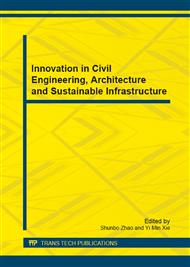[1]
J. Shen, Y. M. Xie, X. Huang, S. Zhou, D. Ruan, Mechanical properties of luffa sponge, J. Mech. Behav. Biomed. Mater., (2012) (in press and available online).
Google Scholar
[2]
M. A. Meyers, P. -Y. Chen, M.I. Lopez, Y. Seki, A.Y.M. Lin, Biological materials: a materials science approach, J. Mech. Behav. Biomed. Mater., 4 (2011) 626-657.
Google Scholar
[3]
L. J. Bonderer, A. R. Studart, L.J. Gauckler, Bioinspired design and assembly of platelet reinforced polymer films, Science, 319 (2008) 1069-1073.
DOI: 10.1126/science.1148726
Google Scholar
[4]
Z. Zhang, Y. Zhang, H. Gao, On optimal hierarchy of load-bearing biological materials, Proc. R. Soc. B, 278 (2011) 519-525.
DOI: 10.1098/rspb.2010.1093
Google Scholar
[5]
I. O. Oboh, E. O. Aluyor, Luffa cylindrica - an emerging cash crop, African J. Agr. Res., 4 (2009) 684-688.
Google Scholar
[6]
M. J. John, S. Thomas, Biofibres and biocomposites, Carbohydr. Polym., 71 (2008) 343-364.
Google Scholar
[7]
K. E. Bal, Y. Bal, Gross morphology and absorption capacity of cell-fibers from the fibrous vascular system of loofah (luffa cylindrica), Text. Res. J., 74 (2004) 241-247.
DOI: 10.1177/004051750407400310
Google Scholar
[8]
H. Demir, U. Atikler, D. Balköse, F. TihmInlIoglu, The effect of fiber surface treatments on the tensile and water sorption properties of polypropylene-luffa fiber composites, Compos. Part A, 37 (2006) 447-456.
DOI: 10.1016/j.compositesa.2005.05.036
Google Scholar
[9]
I. O. Oboh, E. O. Aluyor, T. O. K. Audu, Application of luffa cylindrica in natural form as biosorbent to removal of divalent metals from aqueous solutions - kinetic and equilibrium study, in: F.S.G. Einschlag (Ed. ) Waste Water - Treatment and Reutilization, InTech, 2011, pp.195-212.
DOI: 10.5772/16150
Google Scholar
[10]
Y. Laidani, S. Hanini, G. Henini, Use of fiber luffa cylindrica for waters traitement charged in copper, Study of the possibility of its regeneration by desorption chemical, Energy Procedia, 6 (2001) 381-388.
DOI: 10.1016/j.egypro.2011.05.044
Google Scholar
[11]
G. Siqueira, J. Bras, A. Dufresne, Luffa cylindrica as a lignocellulosic source of fiber, microfibrillated cellulose, and cellulose nanocrystals, BioResources, 5 (2010) 727-740.
Google Scholar
[12]
M. F. Ashby, A. G. Evans, N. A. Fleck, L. J. Gibson, J. W. Hutchinson, H. N. G. Wadley, Metal foams: a design guide, Butterworth-Heinemann, Warrendale, (2000).
DOI: 10.1016/b978-075067219-1/50001-5
Google Scholar
[13]
M. Johnsona, S. L. Walterb, B. D. Flinnc, G. Mayerc, Influence of moisture on the mechanical behavior of a natural composite, Acta Biomater., 6 (2010) 2181-2188.
Google Scholar
[14]
L. J. Gibson, M. F. Ashby, B. A. Harley, Cellular Materials in Nature and Medicine, Cambridge University Press, Cambridge, (2010).
Google Scholar
[15]
M. A. Paglicawan, M. S. Cabillon, R. P. Cerbito, E. O. Santos, Loofah fiber as reinforcement material for composite, Philipp. J. Sci., 134 (2005) 113-120.
Google Scholar
[16]
M. Avalle, G. Belingardi, R. Montanini, Characterization of polymeric structural foams under compressive impact loading by means of energy-absorption diagram. Int. J. Impact Eng. 25 (2001) 455-472.
DOI: 10.1016/s0734-743x(00)00060-9
Google Scholar
[17]
T. A. Schaedler, A. J. Jacobsen, A. Torrents, A. E. Sorensen, J. Lian, J. R. Greer, L. Valdevit, W. B. Carter, Ultralight metallic microlattices, Science, 334 (2011) 962-965.
DOI: 10.1126/science.1211649
Google Scholar


